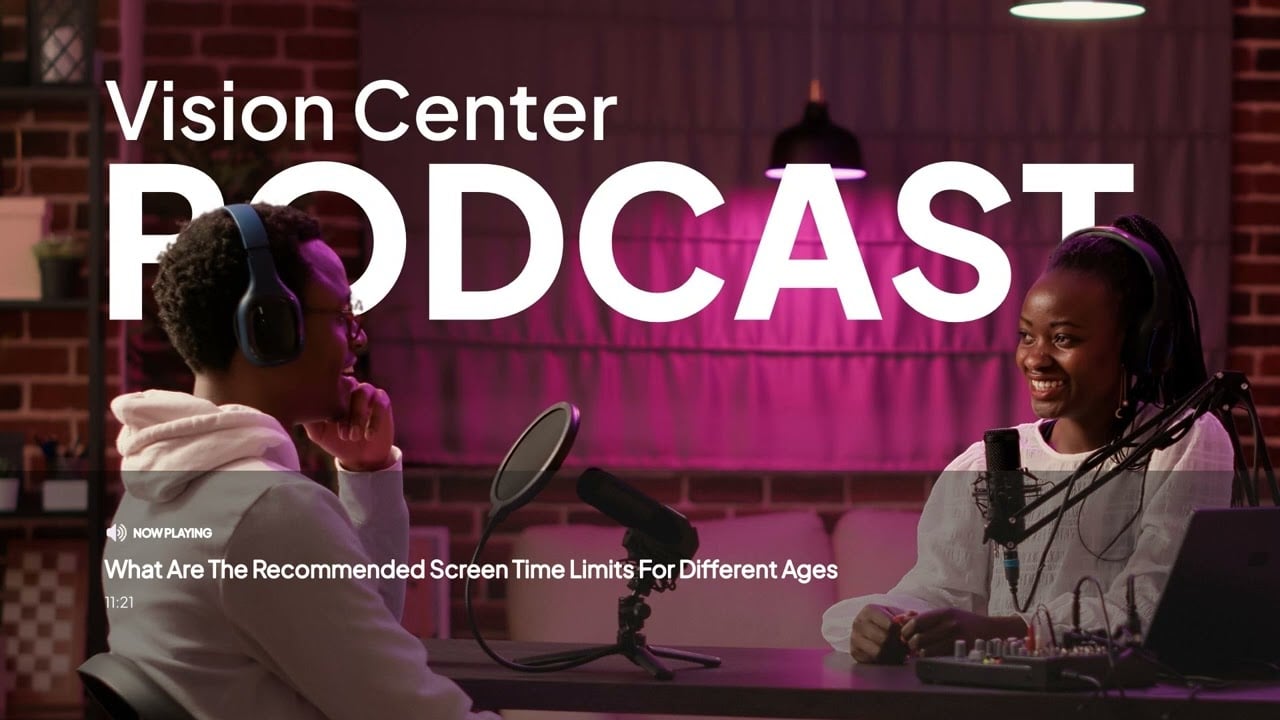As a parent or educator, you might often wonder about the right amount of screen time for your children or students. This is a valid concern, especially in today's world, where screens are everywhere.
While technology can be a valuable tool for learning and entertainment, it's important to strike a healthy balance. In this article, we’ll discuss the recommended screen time for different age groups and strategies for managing screen time.
Listen In Q&A Format
Screen Time Guidelines by Age
Vision Center Podcast
Recommended Screen Time Guidelines by Age
Screen time guidelines can vary depending on a child's age and developmental stage. Understanding these recommendations can help you establish healthy screen time habits for your children.
Under 18 Months
For babies under 18 months, it's best to avoid screen time altogether, except for video chatting with loved ones. Their little brains develop rapidly, and they learn best through real-life interactions and hands-on exploration.
Toddlers and Preschoolers
You can start introducing high-quality educational shows and apps between 18 and 24 months, but always co-view with your child to help them understand what they see.
It's generally recommended that children between the ages of 2 and 5 limit screen time to no more than one hour a day of high-quality programs.
Elementary and Beyond
There isn't a magic number of screen time hours for children ages six and older. Instead, focus on setting consistent limits and ensuring that screen time doesn't interfere with sleep, physical activity, and other important activities.
Teenagers
As kids become teenagers, their screen time needs naturally increase due to schoolwork and social connections. It's important to work with your teen to create a personalized screen time plan that balances their needs with healthy habits.
Where to Buy Glasses + Contacts
Best Overall: Warby Parker
Fastest Delivery: EyeBuyDirect
Also Great: Liingo
Best Place to Buy Contacts: Discount Contacts
Strategies for Managing and Monitoring Screen Time
Many parents face the challenge of managing screen time, especially for children. However, implementing effective strategies can help strike a healthy balance between technology and other activities.
1. Set Clear Limits and Expectations
Setting clear boundaries helps you establish and promote responsible technology use. Establish clear, age-appropriate screen time limits based on recommendations or your family's unique needs.
You can involve your children in the discussion, explaining the importance of balance and the reasoning behind the limits. Use visual timers or apps to track screen usage and facilitate smoother transitions.
2. Create Tech-Free Zones and Times
Creating designated tech-free zones and times encourages family interaction and promotes healthier sleep habits for children. To do this, you can:
- Designate areas like bedrooms and dining rooms as tech-free zones.
- Establish regular tech-free times, such as an hour before bedtime.
- Consider a weekly "screen-free" day filled with alternative activities.
3. Encourage Alternative Activities
Providing children with engaging alternatives to screen time helps them develop new skills while maintaining a healthy lifestyle.
These are ways to encourage alternative activities for your kid:
- Promote outdoor play and physical activities for children's well-being.
- Explore hobbies and interests beyond screens, like sports, music, arts, and crafts.
- Make discovering new passions fun and exciting.
4. Model Healthy Screen Habits
Children often learn by observing their parents' behavior. Here are ways to demonstrate responsible technology use to set a positive example:
- Be mindful of your own screen time and set a positive example for your children.
- Put away your phone during family time and prioritize face-to-face interactions.
- Show the importance of balance and strengthen your connection with your children.
5. Utilize Technology Mindfully
Technology can be a valuable tool for learning and communication when used intentionally. You can actively engage with your child's screen time activities by choosing educational apps and games that promote active participation and critical thinking.
Co-view content with your child and engage in conversations to help them develop critical thinking. Doing this can also foster learning and develop digital literacy skills.
How Does Screen Time Impact Child Development?
As a parent and teacher, it's natural to be curious about how screen time affects children. While technology can be engaging, it's essential to understand its potential impact on a child's development.
- Language and communication. Research suggests that excessive screen time can delay language development in young children. They need real-life interactions and conversations with caregivers to build strong language skills.
- Problem-solving and critical thinking. Spending too much time passively consuming media can limit opportunities for hands-on exploration and problem-solving, hindering the development of critical thinking skills.
- Attention and focus. The rapid pace of many digital activities can train young minds to expect constant stimulation, making it more difficult to concentrate on tasks that demand sustained attention.
- Physical development. Excessive screen time in babies has been linked to delays in fine motor skills development. Additionally, screen time often replaces physical activity, which is crucial for healthy growth.
- Long-term consequences. Research suggests excessive screen time in early childhood could lead to persistent developmental delays and an increased risk of mental health issues such as anxiety, depression, and sleep problems.
It's important to remember that not all screen time is harmful—we need to be cautious about passive and excessive screen use. Educational content and interactive activities can be beneficial when used mindfully and with adult guidance.
By following the strategies outlined in this article, parents and educators can help ensure that children enjoy the benefits of technology while promoting their overall health and well-being.
In this article
Best Places to Buy Glasses

Best Overall
Warby Parker has stylish, high-quality frames at affordable prices.

Also Great
Liingo Eyewear is another great option to buy glasses online.

Best on a Budget
EyeBuyDirect has a wide variety of budget frames starting at $6.
Best Places to Buy Contacts

Best Overall
Discount Contacts is our #1 recommendation to buy contacts online.

Also Great
GlassesUSA has a huge selection of contacts, glasses, & sunglasses.






